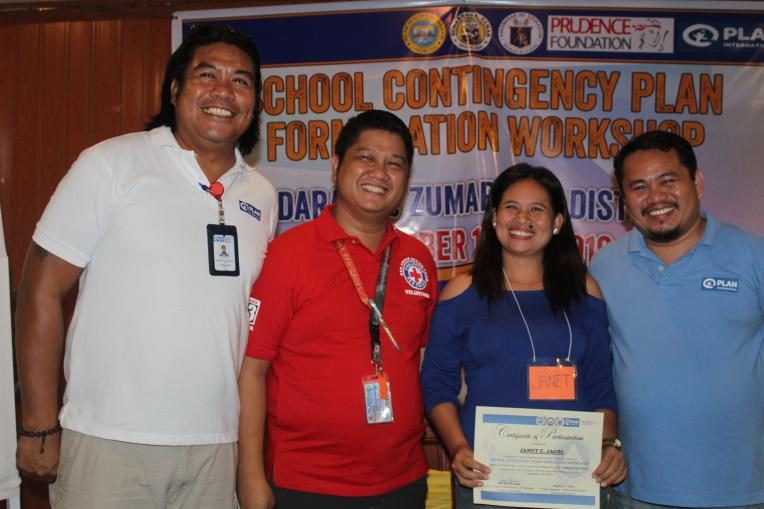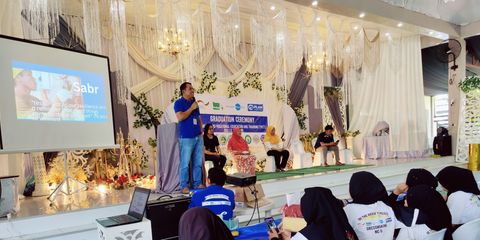27 OCTOBER 2020
“It was in 2011 when the secondary school in Baclayan was established, only 2 years before typhoon Yolanda happened. I was assigned as the School Disaster Risk Reduction and Management (DRRM) Coordinator and all school personnel were required to learn DRRM since it was needed at that time,” shares Teacher Janet, 35, who had limited knowledge prior to her assignment as DRRM Coordinator of Baclayan National High School.

The school is located in Daram, an island municipality of Western Samar province which is prone to hazards such as typhoon, flooding, landslide, and earthquake. It is also near a creek that has high probability of erosion during typhoons and heavy rains.
“Our Yolanda experience pushed us to embrace DRRM. Fortunately, Plan International Philippines implemented the Safe Schools 2 Project where our school was identified as one of the beneficiaries.”
Through the Safe Schools 2 project, teacher Janet and her colleagues in school underwent series of trainings on basic DRRM concepts, risk assessment, organization of school DRRM team, and development of school contingency and DRRM plans. The project supported the school in retrofitting 3 classrooms and provided standard DRRM equipment. School and community representatives were likewise oriented on Construction Monitoring Checklist to ensure that standard materials, steps, and practices were followed during the retrofitting. These initiatives came just in time as the school was starting to establish its own DRRM efforts.
Teaching by leading
Gaining confidence from what she learned from the trainings provided by Plan International Philippines, teacher Janet organized the school’s DRRM team composed of teaching personnel, and led the development of their school contingency and DRRM plans.
Later on, she focused on organizing the Student-led School Watching and Emergency Response Team (SWERT), composed of student leaders. Together with team from Plan International Philippines, teacher Janet trained students on basic DRRM concepts, children’s rights, and school watching and hazard mapping. She also helped in conducting a school DRRM camp where students were trained on basic life skills such as first aid, knot-tying, basic life support, and water safety.
“I, together with Plan International Philippines and the school DRRM team, was able to organize the SWERT in our school. We were able to provide the trainings to the students and guide them in the School Watching and Hazard Mapping activities. Later on, the SWERT led the peer to peer information dissemination in school, and provided support in other school-based DRRM activities. Some SWERT members were also consulted in developing school plans.”
To ensure that all DRRM efforts are sustained, Teacher Janet saw to it that the DRRM plans drafted based from the consultations with students and personnel were integrated in their long-term School Improvement Plan (SIP).
“The SIP has an allocated budget per year given by the Department of Education; so we really made sure that DRRM activities are included in the SIP to be implemented.”
In 2019, Teacher Janet was awarded Most Outstanding School DRRM Coordinator in Western Samar District because of her leadership, dedication, and hard work in their school’s DRRM efforts. She was also designated as the District DRRM Coordinator of Daram 1 for secondary schools. She is now in charge of coordinating with all school DRRM coordinators in Daram District 1 to provide information and instruction from the division level. In her new role, she gets invited to share their school’s best practices, facilitate sessions during provincial-wide activities, and speak during trainings of other school DRRM coordinators. Teacher Janet shares that the Safe Schools 2 Project has empowered her to become a leader in DRRM not only in their school but also in other schools up to the district level.
Teaching beyond the campus
Other than the school-based activities, teacher Janet also reaches out to their community leaders to extend her support in their DRRM activities. She proudly explains that their school and community have a harmonious relationship. Community leaders and representatives are regularly invited to their planning sessions, hazard drills, and DRRM camps; while their school is proactive in participating in the community consultations, planning, and other DRRM-related activities.
“Community members and parents would come to school to participate in the school emergency drills, and take active roles by demonstrating simple techniques on family tracing and reunification. The school and community residents work together to promote the culture of safety and disaster preparedness through various activities initiated by the project in our school.
The Safe Schools 2 Project is one of a kind experience for me. It gave me opportunities to grow both in personal and professional aspects, and brought out the best that I can offer to our school, students, and community.It developed me to become the leader I am now. Most importantly, it changed my values and perspectives in life – to be more mindful in protecting the environment as destruction exacerbates impacts of hazards, and to always prepare for the worst—may it be in the community, home, or school setting.”
The Safe Schools Phase 2 is a three year project implemented by Plan International Philippines with the support from Prudence Foundation in the selected schools of Daram and Zumarraga, Western Samar from 2016 to 2019.The project sought to contribute to the global efforts to reduce the suffering of children and their communities due to the effects of human-induced and natural disasters through developing and increasing their resilience against hazards and risks. It intended to apply lessons learned from a similar safe school project and create models for resiliency in the context of small vulnerable islands. It targeted 1,487 school children (701 girls and 786 boys) from 1,982 learners of ten schools in the communities of Daram and Zumarraga.
Categories: Education, Protection from violence


